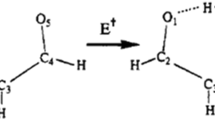Abstract
The electronic structure of the croconate anion is investigated by the semi-empirical VESCF method with CI including up to the doubly excited configurations. The effect of the doubly excited configuration is quite large in the lowest singlet state which turns out to be a ground state, while the calculation including only singly excited configurations produces a triplet ground state. The calculated first transition energy (1 A′1 →1 E′1) is in fair agreement with the observed value. The interpretation of the transition moment in case that the doubly excited configurations are included is also discussed.
Zusammenfassung
Die Elektronenstruktur des Croconat-Anions wurde mit der halbempirischen VESCF-Methode mit Konfigurationswechselwirkung, die bis zu zweifach angeregte Konfigurationen einschloß, untersucht. Der Einfluß der zweifach angeregten Konfigurationen ist im niedrigsten Singulettzustand, der sich als Grundzustand herausstellt, sehr stark. Schließt die Rechnung hingegen nur einfach angeregte Konfigurationen ein, so erhält man einen Tripletgrundzustand. Die berechnete erste Übergangsenergie (1 A′1 →1 E′1 stimmt gut mit dem beobachteten Wert überein. Ebenso wird die Interpretation des Übergangsmomentes für den Fall, daß auch zweifach angeregte Konfigurationen berücksichtigt werden, diskutiert.
Resumé
La structure électronique de l'anion croconique est étudieé par la méthode VESCF semi-empirique avec IC, configurations diexcitées comprises. L'effet des configurations diexcitées est très important sur l'état singulet le plus has qui est un état fundamental, alors que si l'on ne tient compte que des configurations monoexcitées on obtient un état fundamental triplet. La premiére énergie de transition calculée (1 A′1 →1 E′1 est en bon accord avec la valeur observee. Le moment de transition est interprété dans les cas où l'on tient compte des configurations diexcitées.
Similar content being viewed by others
References
Yamada, K., N. Mizuno, and Y. Hirata: Bull. chem. Soc. Japan31, 543 (1958).
Ito, M., and R. West: J. Amer. chem. Soc.85, 2580 (1963).
Baczinger, N. C., J. J. Hegenbarth, and D. G. William: J. Amer. chem. Soc.85, 1539 (1963).
West, R., and D. L. Powell: J. Amer. chem. Soc.85, 2577 (1963).
Baezinger, N. C., and J. J. Hegenbarth: J. Amer. chem. Soc.86, 3250 (1964).
Cignitti, M.: Theoret. chim. Acta (Berl.)5, 169 (1966).
West, R., and H. Y. Niu: J. Amer. chem. Soc.85, 2586 (1963).
Brown, R. D., and M. L. Heffernan: Trans. Faraday Soc.54, 757 (1958).
Matsuoka, O., and Y. I'Haya: Molecular Physics8, 455 (1964).
I'Haya, Y.: Recent Developments in the Generalized Hdckel Method, Advances in Quantum Chemistry, Löwdin ed., p. 211. New York: Academic Press Inc. 1964.
Pariser, R., and R. G. Parr: J. chem. Physics21, 767 (1953).
Flurry, R. L., Jr., E. W. Stout, and J. J. Bell: Theoret. chim. Acta (Berl.)8, 203 (1967).
Mataga, N., and K. Nishimoto: Z. physik. Chem.13, 13, 140 (1957).
Ito, H., and Y. I'Haya: Theoret. chim. Acta (Berl.)2, 247 (1964).
Author information
Authors and Affiliations
Rights and permissions
About this article
Cite this article
Sakamoto, K., I'Maya, Y.J. The role of the doubly excited configurations in the π-electronic structure of the croconate anion. Theoret. Chim. Acta 13, 220–229 (1969). https://doi.org/10.1007/BF01171764
Received:
Issue Date:
DOI: https://doi.org/10.1007/BF01171764




